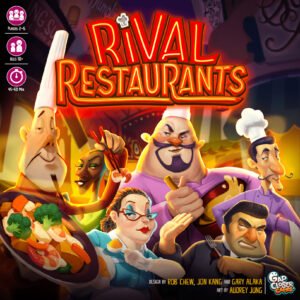 My family and I watch a lot of Top Chef. Initially, I wondered what could be fun about watching a competition TV show about people making food that I can’t eat, but once I started watching I was hooked by the characters, the relationships, the new foods, the history, Padma’s outfits… So, when I saw a Kickstarter for Rival Restaurants, a competitive board game about making food that I can’t eat, I knew I had to back it.
My family and I watch a lot of Top Chef. Initially, I wondered what could be fun about watching a competition TV show about people making food that I can’t eat, but once I started watching I was hooked by the characters, the relationships, the new foods, the history, Padma’s outfits… So, when I saw a Kickstarter for Rival Restaurants, a competitive board game about making food that I can’t eat, I knew I had to back it.
Rival Restaurants is technically a real-time auction-style, set collecting board game, but depending on player count is more of a card drafting game than auction. (More on that later). It’s listed as 2-8 players, for this review I have played with 2-6 players, finding my ideal player count of 4.
Gameplay Overview:
The object of the game is to become the first restaurant to earn 20 popularity points (visualized as the old thumbs up emoji from now on referred to as “likes,” because PP is an abbreviation that will just make me giggle) and be crowned the “Wiener.” (Their pun not mine, and yes I giggled). This is accomplished by buying and/or bartering for ingredients to complete recipes to earn the “likes.” All chefs have two recipes, a Basic Recipe and a Gourmet Recipe. The more complicated the recipe the more “likes” (good) and garbage (bad) are generated.
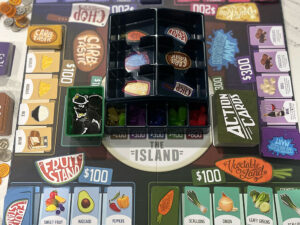
Gameplay consists of three phases each “day”
- Money and Move (untimed phase) First you collect your revenue and then select which market and which product you want from one of the 6 markets or the Island (the special location where you can upgrade your restaurant, dispose of garbage, and pay for marketing which increases your revenue for future turns)
- Buy and Barter (60-second timed phase) During this phase, if two chefs selected the same ingredient they bid on that ingredient, otherwise, you just pay the listed price. You may also barter for items in other chefs’ pantries, pay them to take out your garbage, or bribe them to buy ingredients from the market they chose.
- Cook and Counter (untimed phase) If you have completed one of your recipes you “cook” it and collect your likes and your garbage. After cooking you reset the counters at each market expiring the oldest ingredient.
These three phases are repeated each day until one chef has 20 popularity points. This can be made easier or harder by using your chef’s unique power, an action card, or by purchasing upgrades at the Island.
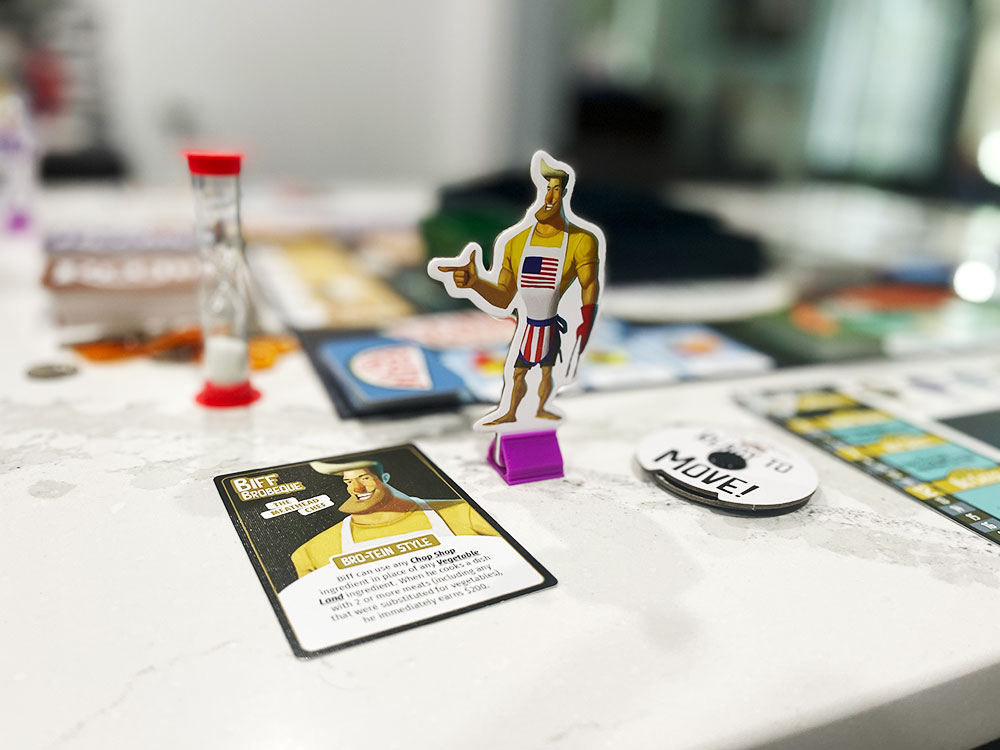
Game Experience:
This game plays fast like a non-cooperative version of the video game Overcooked with the timer on the app being reminiscent of the anxiety that Perfection* generated in my youth. For those of you unfamiliar with the video game Overcooked it is known in my house as “Scream at my friends and family” or “It’s time to get divorced,” depending on who is playing.
The “Buy and Barter” phase can devolve into a progressively louder yelling of trade offers, like “C’mon give me your shellfish for my potato” followed by someone else yelling, “Don’t give him shellfish you idiot, he’ll finish his recipe and win,” and of course the tongue twister, “Don’t be selfish with your shellfish!” Just as often everyone can be going for the different ingredients at different markets and have easy trades, so it’s not always a stressful phase.
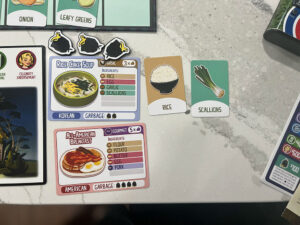
“The Money and Move” and “Cook and Counter” phases are straightforward and stress free unless someone plays an action card that ruins your day, for example, Raiders of the Lost Pork allows the chef to steal one of your ingredients or Taxes where they steal $200 from each chef. There are 8 Clam-Voyance cards that block action cards played against you.
While Action cards are powerful, they cost $300 and that is enough to buy 3 ingredients at many of the markets. As mentioned above the game plays fast, so while you are spending a day buying an action card, another chef is completing a recipe, gaining “likes” and getting closer to winning the game. So, we have not used more than the starting action card in most games, with the exception of during games with larger player counts as the cards that affect multiple chefs become more powerful.
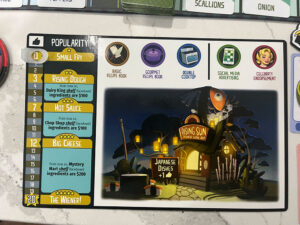
There are 8 cuisine-themed restaurants that receive a bonus for cooking a corresponding recipe. This makes recipes an option for bartering too, in order to gain an extra “like” by making Japanese dishes at your Rising Sun Sushi Bar, for example. Each restaurant also has three unique bonuses that you gain as your restaurant becomes more popular. Now kids these days claim everything is OP, but we have sincerely found that the American BBQ restaurant is really overpowered as it won in every game that this restaurant was selected. The bonuses grant you upgrades that cost all other restaurants a total of $1300. I highly recommend not using this restaurant unless you have a smaller child or a friend that ruins game night if they don’t win.
Bartering is never my favorite dynamic in games, but this game addresses it in a few ways. Near the end of the game, there are naturally fewer trades as no one wants to help someone else win. Also, the timer prevents analysis paralysis, but if you are playing with younger players or people who take longer to make any decision, I may recommend extending the timer to longer than 60 seconds. Speaking of the timer, there is a free app that keeps everyone in turn order and has an anxiety-inducing ticking final 5 seconds, it is more fun than the included sand timer, but does add more noise to a noisy round. There is a variant where you make the “Buy and Barter” phase untimed and I recommend that for learning and playing with children, but it does extend game time.
Final Thoughts:
Rival Restaurants is a fun fast-paced game that I enjoy. I think with a player count of more than 4-5 it turns into a very loud game during the “Buy and Barter” phase and the 60-second counter does not give you enough time to see what the other chefs have/need to make correct decisions. Some people will really enjoy that, strategists will not. Heck, I really enjoy it in the old-school game Pit, but I frequently play this game with my kids and they stress out and make terrible decisions that give someone else the win.
The two-player Mode plays like a very different game and makes better use of the Chef’s powers, encourages you to use action cards to thwart your only opponent, and requires more strategy in selecting markets.
Final Score: 4 Stars – A fast-paced game that is fun at a variety of player counts gets this well designed true to its theme game delivered to the table a lot.
 Hits:
Hits:
• It’s fun and fast for all age, there is no time to overthink.
• The pace of play is not affected greatly by player count due to the timer.
• It balances the right amount of multiplayer solitaire with occasional “take that.”
• 2-player mode offers a completely different experience.
• The art and components are high quality.
Misses:
• For higher player counts, younger players, and strategists the “Buy and Barter” phase can be a cacophony of noise, go too quickly, and allow the player who understands strategy the least to give the game away to other players.
• The starting ingredients can tilt the game in some players favor
• The restaurants and chef powers seem unbalanced
*Conspiracy Note: Perfection came out in 1973 and Prozac was approved in 1987 just in time for those 7-year-olds playing the game to reach adulthood… coincidence, I think not.





















